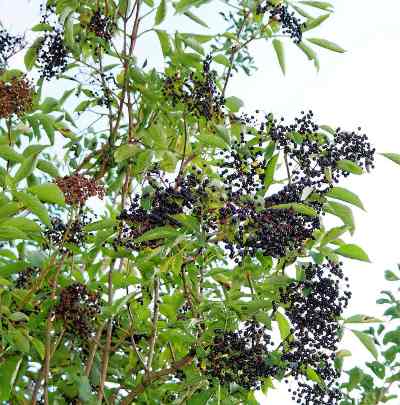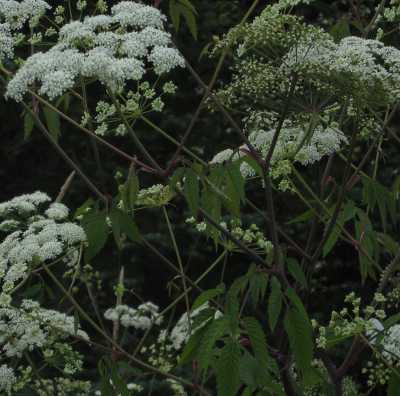Elderberry Wild Edible Food
Elderberry (Sambucus canadensis) is a thornless bush or a rarely a small tree that grows all over the US and Canada. A good place to look is in moist areas along the edges of the woods. Elderberries are green then turn black when they ripen and are about the size of a BB. The leaves are compound leaves that are arranged always with two compound leaves growing opposite of each other.


Elderberry bushes have edible flowers and berries. Ever heard of Elderberry Wine? Probably. This isn't just a food to eat in a life and death situation, Elderberry has long been a source of nourishment and is high in antioxidants.
You can eat the flowers raw and ripened berries after they have been cooked, however, avoid the green unripened berries.
Caution:The biggest concern with Elderberry is that there are a few plants that can be confused with Elderberry that are highly toxic, but don't worry there are easy ways to distinguish between them and once you are familiar with Elderberry there will be no mistaking it. Also Elderberry has a stimulating effect on the immune system so if you have any auto-immune disease you should avoid eating elderberry. Auto-immune diseases such as lupus, Gullain Barre Syndrome, multiple sclerosis, rheumatoid arthritis sufferers are examples of diseases that if you had or have one of these then out of an abundance of caution you should avoid Elderberry.
Pokeberry aka Pokeweed, Dwarf Elderberry and Water Hemlock are three plant species that could be mistaken for Elderberry. Pokeberry can be distinguished by their fruit being arranged on the plant in smaller groups. They sort of hang like a large ear ring instead of huge clusters.
Dwarf Elderberry has its fruit standing high whereas Elderberry plants always have their berries hanging down from the weight.
Water Hemlock grows only in the West and has different leaf margins than Elderberry. The leaves of the Water Hemlock have widely spaced teeth whereas the Elderberry has smaller more closely spaced teeth. The veins of the Water Hemlock always end in a notch of one of the teeth. The leaflets of the Water Hemlock are narrower than those of Elderberry and the leaf veins are straighter unlike the large curved path of Elderberry leaflets.
So how to prep Elderberry to eat? As stated you can eat the flowers raw. You can cook them however you like but raw will be the easiest and best way nutritionally to eat them.
To eat the berries you must first prepare them. After collecting the berries remove all stem material which is poisonous, wash them well. Drip dry the berries for a minute and place them in a pan or skillet. Add low heat slowly until the berries begin to cook and the juice covering the bottom of the pan. At this point you want to bring up the heat a bit and mash/crush the berries. Remove from most heat and just let them simmer for 8 minutes.
Next, strain the juice from the mashed skins and seed. You are tying to collect as much of the juice as possible. The juice can be turned into jelly or used as is, use it like you would syrup.
Elderberries can be cooked in pies. Yumm!
Elderberry wine is another option. To make the wine you will need a bunch of ripe Elderberries, water, sugar, and dried grapes/muscadines if you have any.
Place the cleaned washed Elderberries in a sealable jar then bring water to a boil and pour over the berries with enough water to cover them completely. Be sure that the jar with the berries is heated already or the glass will break. Be sure to not fill the jar completely as you need a vapor space due to swelling of the berries.
Place a lid on and allow the jar to sit outside in the sun for three days. A lid should be on the jar but you do not want it air tight. It must be able to breath a little or you can periodically open and close the lid.
Next strain the berries and recover as much of the liquid as possible. Pour juice back into the jar. Stir in sugar. It should all dissolve. Add chopped raisins if you have them. Again place the lid and allow it to sit inside for about three weeks. The lid should have the smallest hole possible or be put on loosely to allow the pressure that will build up to escape.
After three weeks strain the liquid and pour into bottles and cork the bottles. Periodically remove the cork to allow the gas to escape. After doing this for a while, it varies on how long, you will notice that pressure is no longer building beneath the cork. At this time the wine is ready! Wine should be stored on its side!


Elderberry bushes have edible flowers and berries. Ever heard of Elderberry Wine? Probably. This isn't just a food to eat in a life and death situation, Elderberry has long been a source of nourishment and is high in antioxidants.
You can eat the flowers raw and ripened berries after they have been cooked, however, avoid the green unripened berries.
Caution:The biggest concern with Elderberry is that there are a few plants that can be confused with Elderberry that are highly toxic, but don't worry there are easy ways to distinguish between them and once you are familiar with Elderberry there will be no mistaking it. Also Elderberry has a stimulating effect on the immune system so if you have any auto-immune disease you should avoid eating elderberry. Auto-immune diseases such as lupus, Gullain Barre Syndrome, multiple sclerosis, rheumatoid arthritis sufferers are examples of diseases that if you had or have one of these then out of an abundance of caution you should avoid Elderberry.
Pokeberry aka Pokeweed, Dwarf Elderberry and Water Hemlock are three plant species that could be mistaken for Elderberry. Pokeberry can be distinguished by their fruit being arranged on the plant in smaller groups. They sort of hang like a large ear ring instead of huge clusters.
Dwarf Elderberry has its fruit standing high whereas Elderberry plants always have their berries hanging down from the weight.
Water Hemlock grows only in the West and has different leaf margins than Elderberry. The leaves of the Water Hemlock have widely spaced teeth whereas the Elderberry has smaller more closely spaced teeth. The veins of the Water Hemlock always end in a notch of one of the teeth. The leaflets of the Water Hemlock are narrower than those of Elderberry and the leaf veins are straighter unlike the large curved path of Elderberry leaflets.
To eat the berries you must first prepare them. After collecting the berries remove all stem material which is poisonous, wash them well. Drip dry the berries for a minute and place them in a pan or skillet. Add low heat slowly until the berries begin to cook and the juice covering the bottom of the pan. At this point you want to bring up the heat a bit and mash/crush the berries. Remove from most heat and just let them simmer for 8 minutes.
Next, strain the juice from the mashed skins and seed. You are tying to collect as much of the juice as possible. The juice can be turned into jelly or used as is, use it like you would syrup.
Elderberries can be cooked in pies. Yumm!
Elderberry wine is another option. To make the wine you will need a bunch of ripe Elderberries, water, sugar, and dried grapes/muscadines if you have any.
Place the cleaned washed Elderberries in a sealable jar then bring water to a boil and pour over the berries with enough water to cover them completely. Be sure that the jar with the berries is heated already or the glass will break. Be sure to not fill the jar completely as you need a vapor space due to swelling of the berries.
Place a lid on and allow the jar to sit outside in the sun for three days. A lid should be on the jar but you do not want it air tight. It must be able to breath a little or you can periodically open and close the lid.
Next strain the berries and recover as much of the liquid as possible. Pour juice back into the jar. Stir in sugar. It should all dissolve. Add chopped raisins if you have them. Again place the lid and allow it to sit inside for about three weeks. The lid should have the smallest hole possible or be put on loosely to allow the pressure that will build up to escape.
After three weeks strain the liquid and pour into bottles and cork the bottles. Periodically remove the cork to allow the gas to escape. After doing this for a while, it varies on how long, you will notice that pressure is no longer building beneath the cork. At this time the wine is ready! Wine should be stored on its side!

